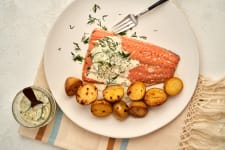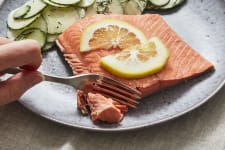Wild salmon is an unparalleled food for children with properties that directly and indirectly support healthy brain function and development. While the combined effects of its fat content, low levels of contamination, and versatility in the kitchen make it a no-brainer (pun intended), when it comes to choosing a brain food appropriate for all ages, wild salmon is queen.
Click here to buy some of the best wild-caught sustainable salmon on the planet, and below are ten reasons why wild salmon is the ultimate brain food for your growing child:
1. It’s Low in Mercury
Mercury intake is unhealthy for people of all ages, but it’s especially damaging for the developing brain. Children whose diets contain mercury, usually consumed through oily fish, experience verbal deficits, poorer scores in memory tests, and cognitive development delay. Since wild salmon contains low levels of mercury, it’s a much safer option than canned tuna when you’re packing up a cold lunch for your child (1).
2. It’s Easy to Cook
For busy parents, quick, easy, healthy, and crowd-pleasing dinner recipes are a godsend, making wild salmon the perfect go-to dish on a school night. A fillet of wild salmon just so happens to be easier to cook than an egg.
3. Wild Salmon Can Make You Smarter
As brain food, wild salmon can be a great equalizer when it comes to better educational performance. Whether parents were lowly-educated or highly-educated, studies show that children who consume fish received higher grades in school than their peers. Even consuming fish just once a week resulted in higher grades, while children in the study who consumed fish more than once a week had the highest grades of all (2).
4. Its Overall Benefits Grow As Your Child Grows
The cognitive benefits of eating wild salmon as a teenager can last well into adulthood. One study found that fifteen-year-olds who ate fish more than once a week had significantly higher cognitive performance scores at age 18, compared to their peers who ate less than one serving of fish each week (3).
5. Wild Salmon is Chock-Full of the Best Kind of Omega-3s
Both fish and plant-based sources can contain omega-3 fatty acids, but the omega-3s in fish come in the form of cognitively beneficial DHA. One study that compared fish oil supplementation with corn oil supplementation — both of which contain healthy omega-3s — in pregnant women found that only maternal intake of fish was associated with significantly better cognitive ability in their children by the time they reached four years of age. Wild salmon contains DHA, so it may help support healthy cognitive development (4).
6. An Asset Against Childhood Obesity
Though the relationship between childhood obesity and cognition is complex, studies have established an inverse association between BMI and cognitive control. As a lean, unprocessed source of protein, wild salmon can fuel your child’s physical pursuits while keeping your child’s appetite satisfied (5).
7. They’ll Sleep Better
Improving the quality of your child’s sleep is one way to boost their intelligence. Interestingly, this is one way that wild salmon can function as the ultimate brain food. A recent study connected frequent fish consumption in children between the ages of 9 and 11 with high quality sleep. Both of these factors were associated with higher IQ scores by the time they reached 12 years of age, and the effects were dose-dependent; in other words, the more fish a child eats, the better the sleep and the higher the IQ (6).
8. You’ll Sleep Better Too
For pregnant mothers, getting enough DHA during pregnancy helps to modulate infants’ circadian rhythm within 48 hours of birth, giving them a head start on establishing healthy sleep patterns that will follow them through infancy. In one study, babies whose mothers consumed 300mg per day of a DHA supplement were less wakeful compared to babies of mothers who had received a placebo, which is an added bonus to sleep-deprived parents (7).
Experts recommend that pregnant women consume at least 200 mg of DHA each day. A serving of wild coho salmon contains about 600mg of DHA per serving, so mothers-to-be who want to achieve this goal would need to consume wild salmon a little over twice a week (8).
9. Brain-Supporting Properties While In Utero
Pregnant women who eat more than two servings of fish each week are introducing their children to brain food even before they leave the womb. These effects were apparent at 6 and 18 months for language skills, 36 months for hand-eye coordination, and IQ by age 4. In contrast, two or less servings per week did not demonstrate any improvement in any of these markers of cognitive development. These benefits were offset by mercury consumption, so it’s critical for mothers-to-be to choose a low-mercury fish like wild salmon (9).
10. Wild Salmon is as Beneficial as Breastfeeding When It Comes to Child Development
Like fish, breast milk contains omega-3s. For mothers who choose not to breastfeed or are unable to do so, having eaten plenty of wild salmon during pregnancy is a way to ensure that their children will reap the early developmental benefits of omega-3 consumption (10).
The easiest way to regularly incorporate sustainable seafood into your diet is to connect directly with a trusted supplier, such as the Wild Alaskan Company, a direct-to-consumer seafood membership service that takes the guesswork out of feeding sustainable seafood to your family.
- https://www.ncbi.nlm.nih.gov/pubmed/19909946
- https://www.ncbi.nlm.nih.gov/pubmed/19817726?dopt=Abstract
- https://www.ncbi.nlm.nih.gov/pubmed/19006530?dopt=Abstract
- https://www.ncbi.nlm.nih.gov/pubmed/12509593?dopt=Abstract
- https://academic.oup.com/cercor/article/24/3/654/392883
- https://www.nature.com/articles/s41598-017-17520-w
- https://www.ncbi.nlm.nih.gov/pubmed/22269042?dopt=Abstract
- https://www.ncbi.nlm.nih.gov/pmc/articles/PMC3046737/
- https://www.ncbi.nlm.nih.gov/pubmed/18353804?dopt=Abstract
- https://www.ncbi.nlm.nih.gov/pmc/articles/PMC2875187/






